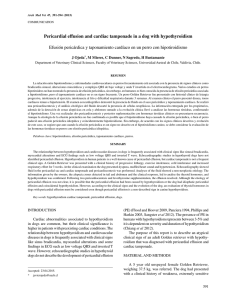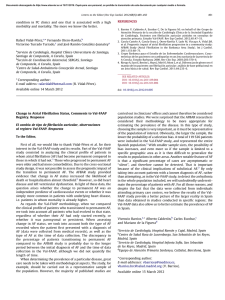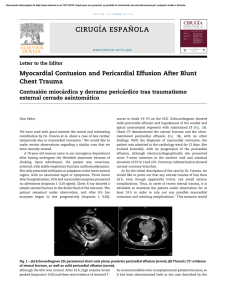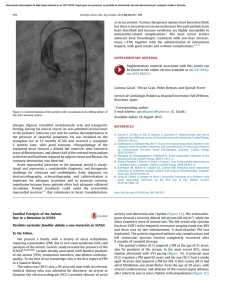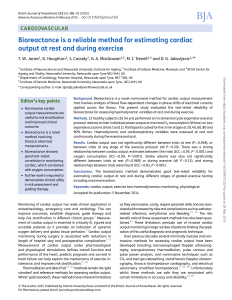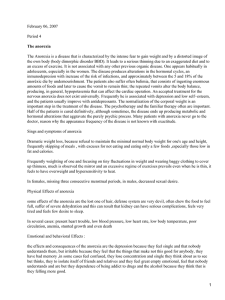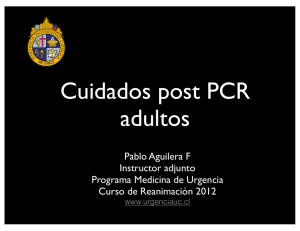CONSTRICTIVE PERICARDITIS IN A 36 YEAR
Anuncio
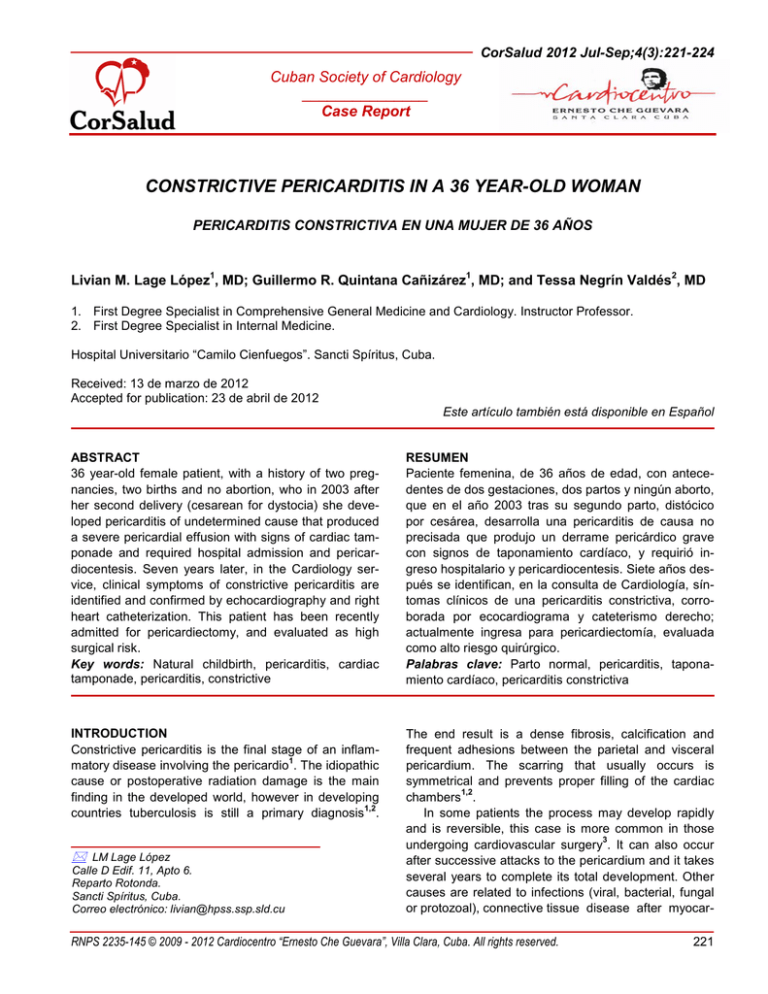
CorSalud 2012 Jul-Sep;4(3):221-224 Cuban Society of Cardiology _______________ Case Report CONSTRICTIVE PERICARDITIS IN A 36 YEAR-OLD WOMAN PERICARDITIS CONSTRICTIVA EN UNA MUJER DE 36 AÑOS Livian M. Lage López1, MD; Guillermo R. Quintana Cañizárez1, MD; and Tessa Negrín Valdés2, MD 1. First Degree Specialist in Comprehensive General Medicine and Cardiology. Instructor Professor. 2. First Degree Specialist in Internal Medicine. Hospital Universitario “Camilo Cienfuegos”. Sancti Spíritus, Cuba. Received: 13 de marzo de 2012 Accepted for publication: 23 de abril de 2012 Este artículo también está disponible en Español ABSTRACT 36 year-old female patient, with a history of two pregnancies, two births and no abortion, who in 2003 after her second delivery (cesarean for dystocia) she developed pericarditis of undetermined cause that produced a severe pericardial effusion with signs of cardiac tamponade and required hospital admission and pericardiocentesis. Seven years later, in the Cardiology service, clinical symptoms of constrictive pericarditis are identified and confirmed by echocardiography and right heart catheterization. This patient has been recently admitted for pericardiectomy, and evaluated as high surgical risk. Key words: Natural childbirth, pericarditis, cardiac tamponade, pericarditis, constrictive RESUMEN Paciente femenina, de 36 años de edad, con antecedentes de dos gestaciones, dos partos y ningún aborto, que en el año 2003 tras su segundo parto, distócico por cesárea, desarrolla una pericarditis de causa no precisada que produjo un derrame pericárdico grave con signos de taponamiento cardíaco, y requirió ingreso hospitalario y pericardiocentesis. Siete años después se identifican, en la consulta de Cardiología, síntomas clínicos de una pericarditis constrictiva, corroborada por ecocardiograma y cateterismo derecho; actualmente ingresa para pericardiectomía, evaluada como alto riesgo quirúrgico. Palabras clave: Parto normal, pericarditis, taponamiento cardíaco, pericarditis constrictiva INTRODUCTION Constrictive pericarditis is the final stage of an inflam1 matory disease involving the pericardio . The idiopathic cause or postoperative radiation damage is the main finding in the developed world, however in developing 1,2 countries tuberculosis is still a primary diagnosis . The end result is a dense fibrosis, calcification and frequent adhesions between the parietal and visceral pericardium. The scarring that usually occurs is symmetrical and prevents proper filling of the cardiac 1,2 chambers . In some patients the process may develop rapidly and is reversible, this case is more common in those 3 undergoing cardiovascular surgery . It can also occur after successive attacks to the pericardium and it takes several years to complete its total development. Other causes are related to infections (viral, bacterial, fungal or protozoal), connective tissue disease after myocar- LM Lage López Calle D Edif. 11, Apto 6. Reparto Rotonda. Sancti Spíritus, Cuba. Correo electrónico: livian@hpss.ssp.sld.cu RNPS 2235-145 © 2009 - 2012 Cardiocentro “Ernesto Che Guevara”, Villa Clara, Cuba. All rights reserved. 221 Constrictive pericarditis in a 36 year-old woman dial infarction, drug-induced neoplasms, use of devices or procedures involving the pericardium, trauma, 1-4 among others . The major pathophysiological result is the marked restriction of cardiac filling, which produces elevation and balance of pressures in all chambers, in the peripheral vascular system and pulmonary veins. Both ventricles are filled rapidly in protodiastole by the marked elevation of atrial pressures and a marked ventricular suction, culminating with a reduction of volume ejected in systole. Clinically, the presentation is characterized by signs and symptoms of right cardiac 3 dysfunction . Venous stasis turns into hepatic congestion, peripheral edema, ascites, and occasionally, anasarca and cirrhosis of cardiac origin. The reduction in cardiac output due to inadequate ventricular filling, supported by a constrictive pericardium, causes fatigue, tiredness, weight loss, dyspnea, cough, orthopnea, atrial fibrillation and tricuspid regurgitation. To a lesser extend, syncope and caquexia may be pre1,3-5 sent . The immediate differential diagnosis in a patient with constrictive pericarditis is restrictive cardiomyo5 pathy, as the procedure to follow is entirely different . CASE REPORT 36 year-old female patient, with a history of two pregnancies, two births and no abortion, who in 2003 after her second delivery (cesarean for dystocia) developed pericarditis of undetermined cause that produced a severe pericardial effusion with signs of cardiac tamponade and required hospital admission and pericardiocentesis. This time she goes to see a cardiologist for dysp- nea after mild or moderate efforts (functional class II-III, according to the New York Heart Association) and occasionally at rest, tachycardia of several months of development and low-intensity edema in lower limbs. On cardiovascular physical examination arrhythmic noises for atrial fibrillation with rapid response are found, without hemodynamic compromise, a first variable sound, second high pitched sound, and no third heart sound; also, systolic murmur III / VI in lower left sternal border that radiates to the apex, blood pressure of 100/60 mmHg, heart rate of 116 beats per minute, a decrease in peripheral pulse amplitude, jugular engorgement and Kussmaul’s sign. A 2 cm hepatomegaly was also found below the costal margin, probably a congestive one. An echocardiogram was performed to evaluate the structural characteristics of the heart and the possibility of atrial fibrillation reversion. The test showed structural characteristics totally different from those expected in a patient of this age. To confirm the diagnosis and to determine the pressures in the heart chambers and the presence or absence of breaks in oxygen saturation, a right heart catheterization was performed. It was then found that there was a slight to moderate increase of right atrial (10 mmHg) and right ventricle (48 mmHg) pressures, aortic pressures were normal (102 mmHg), the final diastolic pressure of the left ventricule was slightly increased and the pressure curve of the right chambers showed square root morphology. Saturations in the vena cava and in the right atrium and ventricle were normal. The definitive diagnosis was constrictive pericarditis and the patient was sent to a referral hospital in Havana for surgery. Figure 1. A. Parasternal long axis. Pericardial effusion located in left ventricular posterior wall. B. Apical 4-chamber view. Dilated right and left atrium, small right ventricle due to extrinsic compression. C. Apical 4-chamber view, tricuspid regurgitation. 222 CorSalud 2012 Jul-Sep;4(3):221-224 Lage López LM, et al. Figure 2. A. Mitral flowchart, variable diastoles by atrial fibrillation. B. Hepatic veins flowchart, an enlarged right atrium can be observed. DISCUSSION Constrictive pericarditis is a progressive disease with the exception of those in whom it has a temporary 6 character . Pericardiectomy is the definitive treatment with a perioperative mortality of 5 to 15%. Patients with other comorbidities or presence of severe disease are considered at high risk for surgery, otherwise pericarpdiectomy should not be delayed once the diagnosis is 3,4 made . Treatment with diuretics and salt restriction are helpful in reducing fluid overload and edema, but these 6,7 are refractory to treatment . Because sinus tachycardia is a compensatory mechanism, beta-blockers and calcium antagonists should be avoided. In patients with atrial fibrillation and rapid ventricular response, the use of digoxin is the initial treatment; the overall rate should not decrease below 80 to 90 beats per minute. About 70 - 80% of patients improve clinically at 5 years of surgery, and 40 to 50% at 10 years of pericardiectomy. Worse results are observed in those that radiations are the causal factor, as well as in those with renal impairment, moderate or severe pulmonary hypertension, left ventricular ejection fraction less than 50.40; hyponatremia and advanced age . Diastolic function, measured by echocardiography, returns early to normal in 40% of cases, and lately in 8,9 57% . Inadequate results or poor response to surgical treatment are seen in patients with longstanding disease, myocardial fibrosis, incomplete pericardial resection, worsening of tricuspid regurgitation or the appearance of cardiac compression by mediastinal in7,10,11 flammation and fibrosis . REFERENCES 1. Tsang TS, Barnes ME, Hayes SN, Freeman WK, Dearani JA, Butler SL, et al. Clinical and echocardiographic characteristics of significant pericardial effusions following cardiothoracic surgery and outcomes of echo-guided pericardiocentesis for management. Mayo Clinic experience, 1979-1998. Chest. 1999;116(2):332-31. 2. Goland S, Caspi A, Malnick S. Idiopathic chronic pericardial effusion. N Engl J Med. 2000;342(19): 1449. 3. Kuvin JT, Harati NA, Pandian NG, Bojar RM, Khabbaz KR. Postoperative cardiac tamponade and the modern surgical era. Ann Thorac Surg. 2002;74(4): 1148. 4. Ling LH, Oh JK, Schaff HV, Danielson GK, Mahoney DW, Seward JB, et al. Constrictive pericarditis in the modern era: Evolving clinical spectrum and impact on outcome after pericardiectomy. Circulation. 1999;100(13):1380-6. 5. Abdalla IA, Murray RD, Lee JC, White RD, Thomas JD, Klein AL. Does rapid volumen loading during transesophageal echocardiography differentiate constrictive pericarditis from restrictive cardiomyopathy? Echocardiography. 2002;19(2):125-34. 6. Breen J. Imaging of the pericardium. J Thorac Imag. 2001;16(1):47-54. CorSalud 2012 Jul-Sep;4(3):221-224 223 Constrictive pericarditis in a 36 year-old woman 7. Haley JH, Tajik AJ, Danielson GK, Schaff HV, Mulvagh SL, Oh JK. Transient constrictive pericarditis: causes and natural history. J Am Coll Cardiol. 2004;43 (2):271-5. 8. Ha JW, Ommen SR, Tajik AJ, Barnes ME, Ammash NM, Gertz MA, et al. Differentiation of constrictive pericarditis from restrictive cardiomyopathy usingmitral annular velocity by tissue Doppler ecocardio-graphy. Am J Cardiol. 2004;94 (3):316-9. 9. Sengupta PP, Mohan JC, Mehta V, Arora R, Khandheria BK, Pandian NG, et al. Doppler tissue imaging improves assessment of abnormal interven- 224 tricular septal and posterior wall motion in constrictive pericarditis. J Am Soc Echocardiog. 2005; 18(3):226-30. 10. Hirai S, Hamanaka Y, Mitsui N, Morifuji K, Sutoh M. Surgical treatment of chronic constrictive pericarditis using an ultrasonic scalpel. Ann Thorac Cardiovasc Surg. 2005;11(3):204-7. 11. Taylor AM, Dymarkowski S, Verbeken EK, Bogaert J. Detection of pericardial inflammation with lateenhancement cardiac magnetic resonance imaging: initial results. Eur Radiol. 2006;16(3):569-74. CorSalud 2012 Jul-Sep;4(3):221-224
